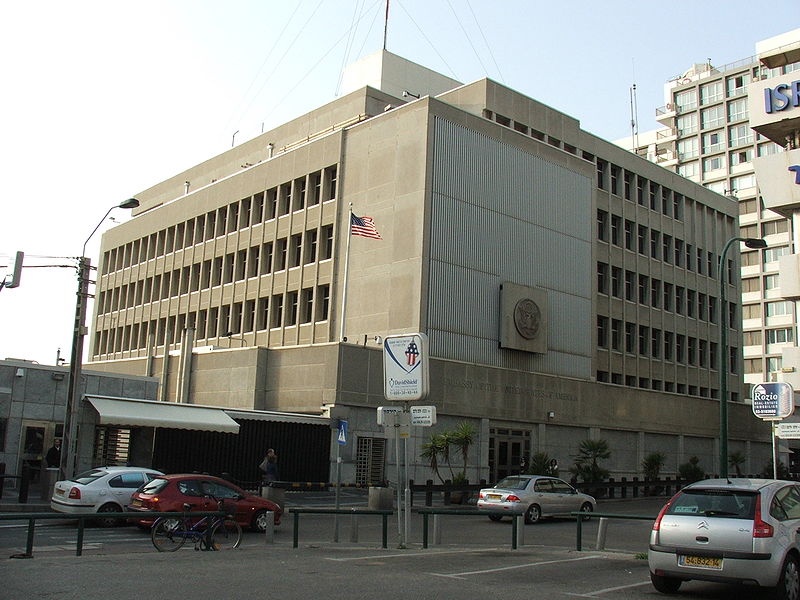I love visiting the United States. I think it’s a gorgeous country with wonderful people and such a variety of activities, landscape, and opportunities for the traveler. Every visit I’ve had there has been exciting and different, unique from all the rest. I’ve met such giving and sweet people there, and they really made the visit so much better. 🙂
The only problem I have with visiting the States is the stress of getting a tourist visa. The people at the embassy and consulates are tough! I always feel like I’m doing something wrong… like I’m trying to fool them into believing I’m only a tourist when my true intention is to illegally move there. (I’m not – I promise!)

I love you guys, but you have the scariest looking embassies in the world! Seriously.
I’ve had enough experience with embassies that I know the drill… so for those of you trying to get a tourist visa to the US, here are a few tips:
1) First of all, CHECK if you need a tourist visa
Visa laws are changing all the time. I was really excited to read on the news that the US was considering adding Israel to the US Visa Waiver problem… they get me thrilled every few months and then it usually doesn’t pass government voting. 🙁 So sad. Chilean citizens are lucky because Chile will soon join the Visa Waiver program, being the first Latin American country to be considered. It gives me hopes that maybe Bolivia will be potentially considered in the future as well, although I do doubt it… but hey, maybe Israel. 😀
2) Research the application process
Each country has its own process for the tourist visa application. Last time I requested a US tourist visa in Israel, I had to apply for it online but pay for it at the post office. I was then provided a calendar with available dates and times for an interview. I was required to arrive at the consulate early for the interview and the approval was issued a few days later. On the other hand, in Bolivia, the process was less computer-based. Everything had to be done in person and it was more bureaucratic. Each country has the process that works best for the citizens and embassy so you should look yours up before starting anything.
3) Go prepared with documentation
American embassies and consulates want to ensure that you’re not planning to stay in the US illegally. In order to convince them against it, you need to prove attachment to your country. Doing so is relatively easy. For example, take documentation if you are currently a university student, show that you have a stable job with a salary, or take bank statements with you. If you have airplane tickets already, show that you have a return ticket purchased. As long as you demonstrate a commitment to stay in your own country, you should be okay.
4) Try to keep your nerves in control
The American embassy is nerve wracking… there’s a lot of security procedures, guards, and the officers are tough and serious. They will ask you a lot of questions, so be ready to respond confidently. Don’t tremble, ramble on nor avoid eye contact. If you seem far too nervous, they may be suspicious of your intentions.
5) Dress the part
Wear nice clothes, as if you were going to an informal business meeting. Not only do Americans appreciate more ‘formal’ attire, it makes you look serious and gives the best possible first impression. I have always dressed presentably and never had an issue with an interviewer.





I didn’t realize it would be that hard to get a tourist visa to to the US.. but then, they are even pretty hard on US citizens sometimes getting back into the US from visiting another country.
It is interesting to red about your experiences coming here!!! I sympathize with your nerves at the embassy – sometimes going through the airport here just to fly to another state makes me feel like a criminal!!!
I need to get a passport. We live on the Canadian border on the USA side. It’s just so expensive for the whole family. Our local USPS is hosting a sign up though.
I need a passport to visit Canaday! Love this post, thanks!
This doesn’t apply to me, but I shared for all my friends who this could really help 🙂
I’m definetely going to share this with my friends who live outside the US! Thanks for the tips!
I’m going to share this with friends in other countries! Thanks!
EEK! I don’t envy you! I get so nervous with things like that. Like you although I’m doing nothing wrong, I feel like I have something to prove!
I would be a nervous wreck to go through all o fthat. So glad I have no plans to travel outside of the coutnry.
These are great tips and I am sure will come in handy for many. I have never even applied for a passport. The few times I have ventured into Canada or Mexio, I have just needed my birth certificate. I need to get a passport because I will be doing some traveling oversees soon.
Some great tips for those that might not know what steps to take. I live in the United States and afraid of flying so I’ll probably never need a visa but I am sure others will use these tips.
Sounds like I would be intimidated as well. I guess they’re not there to make friends, are they?
I think we Americans have a slightly easier time with travel. I do know there are some countries that require visas, but my travels have not taken me there so I don’t know much about the process. I’ll have to remember your tips if I ever get the chance to visit one of them.
Great tips for people outside US & Canada. As Canadian I do not have any problems traveling to US 🙂
I had a tourist Visa at one time in my life and the process today is not as bad as it once was. It’s def much easier to be a U.S. citizen. I do know a lot of friends who might need to know about this for sure though!
Wow, interesting! I never knew there were so many steps in getting a tourist visa.
Thank you! I had no idea what was involved in this process and it all seemed so overwhelming
This is very informative! I will definitely share. Thanks for the NTK tips for when I start traveling and checking off my bucket list.